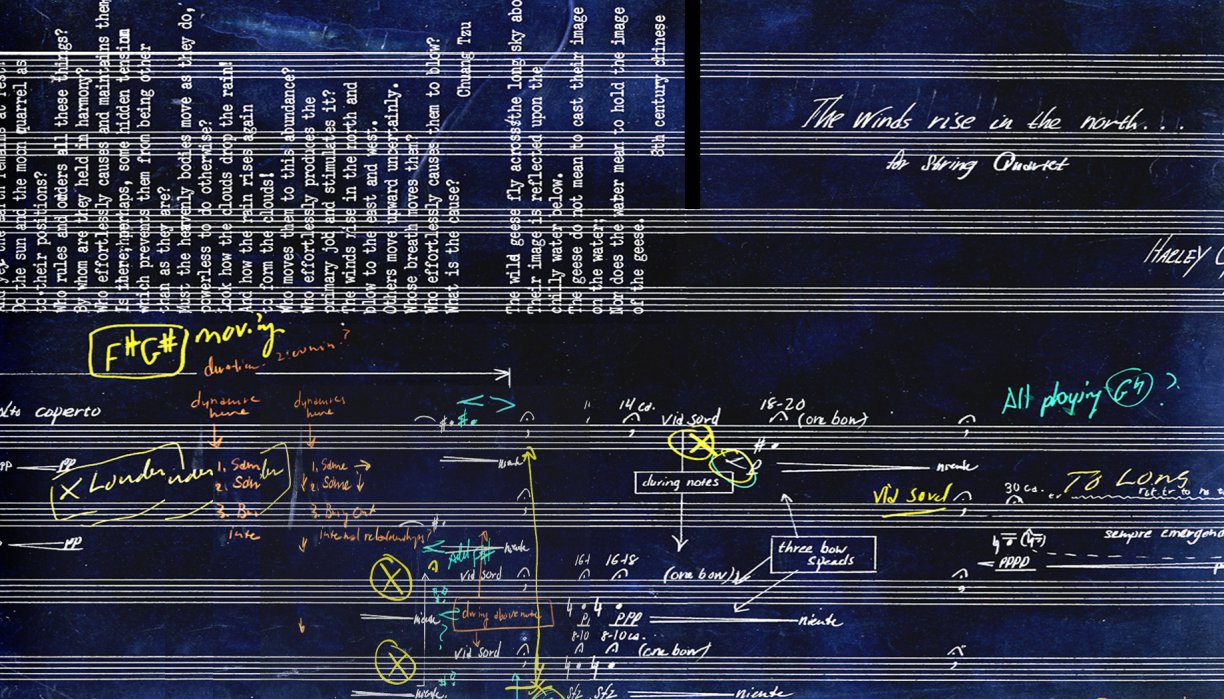Composer Eric Richards on the life and work of his friend and colleague Harley Gaber, originally published in the Frog Peak newsletter following the composer's death in 2011. Gaber is the subject of a composer portrait on Saturday May 24th as part of Tectonics Festival NY, including a performance of his monumental string work "The Winds Rise in the North", and a panel moderated by Richards.
Harley Gaber, an American composer, took his own life in Gallup, New Mexico on June 16, 2011. The body of work he created in the 1970s is among the most distinctive of post-World War II American music.
Harley began composing music of striking originality while still in his teens, first as a student of Horace Reisberg at New Trier High School in Winnetka, Illinois. He continued at the University of Illinois, Champaign-Urbana, where his studies with Kenneth Gaburo became more of a relationship of artistic equals than of teacher and student. Ken and Harley formed a life-long friendship in which they investigated- and challenged- each other's basic aesthetic assumptions. This singular relationship came to an end with Gaburo's death in 1993.
Harley's work manifested his life-long obsession with getting "inside" the music. He notated minute directions for the attack, dynamic changes, and other physical characteristics of each and every note, in ways that, while they might have superficially resembled some of the serial music of that time, were really his attempt to get beyond appearances, and slow down the sense of time in the music through a deeper investigation of the sound itself. This interest was already present in his early works for solo instruments, including "Chimyaku" (alto flute, 1968), "Kata" (violin, 1969), and "Michi" (violin, 1969). "Kata," originally available on an LP produced by CRI, was included on the New World Records CD Gaber/Hellerman/Zorn (NWCRL299, 2010).
This focus was continued in his seminal string music of the 1970s: "Sovereign of the Centre" (four violins, 1972/1974)and "The Realm of Indra's Net" (four tracks of recorded violin, 1974); recordings of these were released on CD in 2010 by Edition RZ (1022), Berlin. The first recording of "The Winds Rise in the North" (string quartet, 1974, rev. with added violin, 1975) was on an LP produced in 1976 by Titanic Records in Cambridge, Massachusets (Ti 16 and 17); the original recording was later remastered by Edition RZ (4008-9), and released on two CDs in 2007.
In these pieces for strings, Harley wanted to actually create the illusion of suspending time and consciousness by letting the kind of minute events and gestures that had been "composed out" in the earlier works now be formed through the use of often unpredictable bridge harmonics. These seemed to almost spontaneously build up in intense aggregations of sound that unfolded extremely slowly as in the earlier carefully notated works, but now in their intensity seemed almost emotionally unbearable for some listeners. For Harley, however, the music reflected "undefined moods and states" often influenced by, or parallel to, feelings expressed in Eastern poetry and philosophy.
Gaber, increasingly uncomfortable in New York in the late 1970s, moved to La Jolla, California in 1978. He held a job for a long time as a restaurant manager, and spent a great deal of his spare time playing tennis, which had increasingly fascinated him in his last years in New York. He devoted more and more time to the visual arts, first to painting, and then to a large-scale project that gradually consumed all his energies. He created a massive, large-scale series of literally hundreds, if not thousands, of drawn-over archival photos and graphics from the Weimar Republic and Nazi Germany, and called it "Die Plage." At one point the drawings filled a hanger-sized building in Newport, Oregon, where Harley spent an increasingly large amount of time. "Die Plage" was mounted a few times as an installation in California and Oregon, but it had nowhere near the impact that Harley had hoped for.
Harley had been fascinated with the music and art of twentieth-century Germany since he was young. He became increasingly preoccupied with an idiosyncratic view of the Holocaust as a metaphor for the ambiguous relationship between Good and Evil, art and real life, and oppressor and oppressed. This viewpoint was explored again many years later, in 2008, with Harley's return to composing.
This was occasioned by a request for a new piece from Harley's oldest and closest friend, William Hellerman of the Downtown Ensemble. The result was "Webern's Gambit," a multi-media work for film and cello that juxtaposed disturbing film imagery, including old German footage and recordings, with a live performance of a cello part derived from pitches in a movement of the Webern "Piano Variations."
While Harley had been reworking and re-editing music by others in the previous few years-more as an exercise in learning GarageBand than anything else-this first foray into original composition after so long proved quite traumatic for him: he simply had not been used to working with others for almost 30 years. This ultimately led to his decision to concentrate on a series of tape pieces, in what would become the last few years of his life.
The realization of these pieces was due in no small part to the emotional support and practical acumen of Philip Blackburn, the director of Innova Records. Blackburn had been a student of Gaburo's for many years at the University of Iowa, and intuitively understood Harley's artistic and emotional needs. Blackburn was instrumental in realizing and producing Harley's last two CDs: first, "I Saw my Mother Ascending Mount Fuji" (tape and processed violin, 2009), followed by "In Memoriam" (tape, 2010), the latter released two weeks before Harley's death.
These works really represented a new attempt by Harley to deal with many different aspects of his life and music. He superimposed music by other composers (Gaburo, Paccione, Blackburn, Verdi, and others) upon natural sounds he created in GarageBand, to create an emotionally somewhat less charged, more varied landscape than the intense string music of the '70s, but with those qualities that characterized all of Harley's art-careful attention to detail, and going deeply below the mere surface of things-in Melville's words, one of "those men who dive" and come "up again with blood-shot eyes."
—Eric Richards, August 2011
Image: Harley Gaber, scores for "The Winds Rise in the North"



